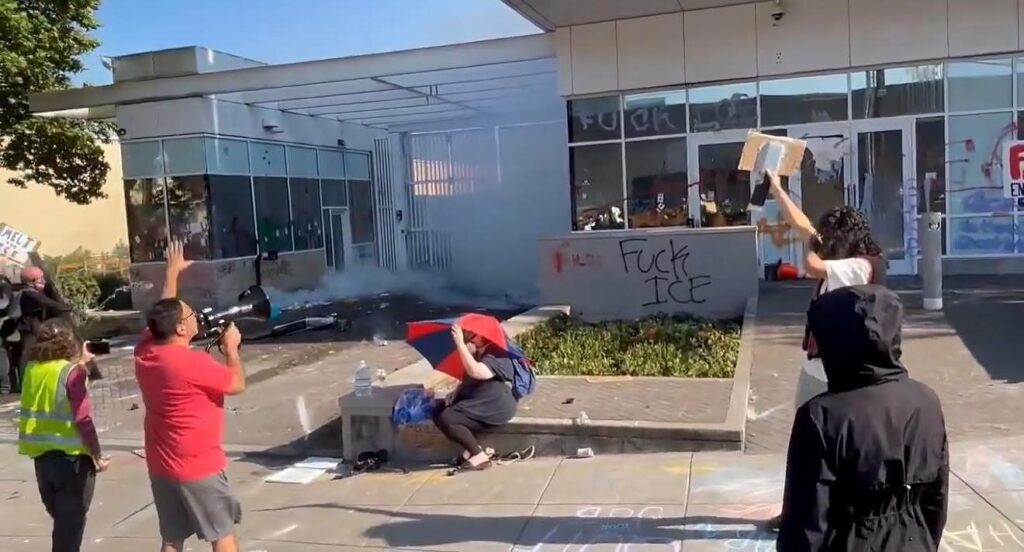PORTLAND, OREGON — Tensions between federal law enforcement and protesters in Portland reached a violent turning point during one of the city’s ongoing demonstrations when a protester was allegedly shot in the eye by a Department of Homeland Security (DHS) officer. The incident, now drawing scrutiny and outrage from some quarters and sharp rebuke from others, is emblematic of the larger national debate over the limits of protest, the use of force by federal agents, and the consequences of direct confrontation in the streets.
The protester, whose identity has been widely circulated on social media, reportedly suffered a severe eye injury after a projectile — believed to be a less-lethal round — struck his face during a confrontation outside the federal courthouse. Despite the injury, he later told reporters: “I have to have my say, and if it means being wounded to do it, then I’m here.”
His statement has been both lauded as courageous and criticized as reckless, depending on which side of the increasingly polarized public discourse one finds themselves.
The Incident and Its Fallout
The event took place amid nightly protests in downtown Portland, many of which have escalated into clashes between demonstrators and federal officers. The Department of Homeland Security has maintained a significant presence in the area, citing the need to protect federal property after months of civil unrest.
According to witnesses, the protester had been part of a group that had gathered near the courthouse when tensions flared. Officers allegedly responded with crowd-control measures — including tear gas, flashbangs, and rubber bullets — after individuals in the crowd began throwing objects and shining lasers at agents.
It was during this exchange that the man was struck in the eye. Medics on-site provided first aid before he was transported to a hospital. His condition has since stabilized, but he faces permanent vision loss.
The Department of Homeland Security has yet to confirm whether the injury was caused by one of its officers or which specific munition was used. However, the department has defended its actions broadly, stating that federal agents have shown restraint in the face of ongoing assaults on federal buildings and personnel.
Protest or Riot?
The larger question underlying the incident is whether these demonstrations — some of which begin peacefully but spiral into violence — should be classified as legitimate protest or something more dangerous.
Critics of the protests, including some local and federal officials, argue that the demonstrations have long since devolved into chaos, with agitators hijacking peaceful gatherings to provoke law enforcement, damage property, and defy authority. They claim the real victims are not those injured while clashing with officers, but the officers themselves — forced to face projectiles, firebombs, and daily hostility while simply performing their duty.
“Let’s be clear,” said one former law enforcement official. “When you come to a federal building with fireworks, bricks, and lasers aimed at officers’ faces, you’ve crossed the line from protest to riot. And when people get hurt in those moments, it’s a tragic but foreseeable consequence.”
The phrase “Play stupid games, win stupid prizes” has gained traction online in response to the injured protester’s comments, encapsulating the belief held by some that participation in confrontational demonstrations carries inherent risks — risks for which individuals must take responsibility.
The Other Side of the Debate
Supporters of the protester, however, argue that the use of force by federal agents has been disproportionate and, at times, unlawful. Civil rights groups, legal observers, and some members of Congress have criticized DHS for what they call an authoritarian response to constitutionally protected protest.
“This isn’t just about property damage,” said one civil liberties attorney. “This is about the federal government using dangerous crowd-control weapons against its own citizens. An eye was lost. That’s not a game — that’s a human being exercising their First Amendment rights.”
Calls for independent investigations into DHS conduct in Portland have grown louder in the wake of the injury. Activist organizations continue to demand an end to what they describe as militarized overreach by federal forces.
What Comes Next?
As Portland continues to navigate its long-running protest movement, incidents like this are likely to remain flashpoints in a broader national conversation about protest, law enforcement, and accountability. Whether one sees the protester as a hero, a cautionary tale, or a victim of his own choices often depends less on the facts of the case and more on the perspective through which one views the events.
The only certainty in this uncertain climate is that the line between protest and conflict is thinner than ever — and the consequences, increasingly severe.




